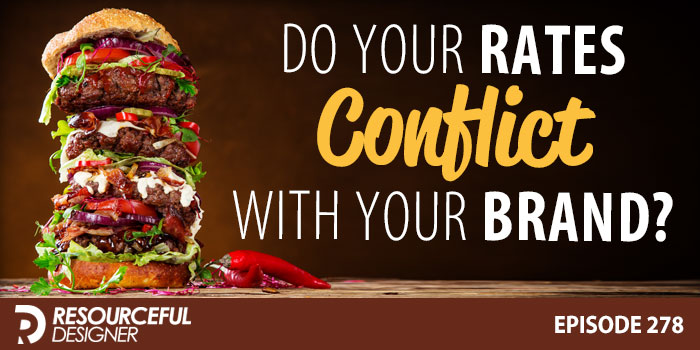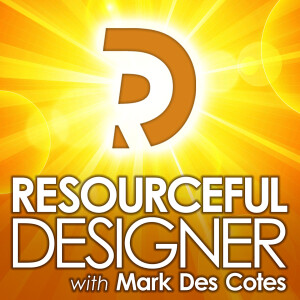
Do Your Rates Conflict With Your Brand? - RD278
 2021-11-29
2021-11-29
I’d like you to imagine this scenario.
There’s a neighbourhood in your city that you love. It has beautiful homes with big yards and lots of green space around. It’s close to amenities like schools and shopping. And the internet infrastructure is state of the art, which we know is a must for what we do as designers.
It’s the type of neighbourhood that you occasionally drive through and think to yourself; I would love to live here.
The problem is, home prices in this neighbourhood are way out of your budget. You figure you can afford maybe $350k. Perhaps you can push it to $400k. But unfortunately, homes in this neighbourhood typically sell for over $700k. But you can dream, can’t you?
Then one day, while driving through the neighbourhood, you see a FOR SALE sign in front of what could be your dream home.
You’ve admired the homes in this neighbourhood for a long time, but always from the outside. But here’s your chance to get a peek on the inside because there are sure to be photos on the realtor’s website.
When you get home, you fire up your browser to take a peek. As you’re navigating to the page, you play the guessing game in your head. You guess its listing price at $795K. But when the page loads, that beautiful house, the one you’ve been admiring for years, is listed at $295k.
What do you think your first thought would be in this situation? Or maybe second thought after you realize you can afford it. You would probably start wondering, what’s wrong with it? Why is it listed so low? What mess would you be getting yourself into if you were to make an offer?
I’m sure you’ve experienced this feeling before. Maybe not with a house. But perhaps with a car, or something else. Especially when the item in question is something previously owned, what’s wrong with it that’s making the seller offer it for such a low price?
It’s not just houses.Something similar happened to a designer friend of mine just a couple of weeks ago.
He was at a business conference, and on one of the days, they divided people up into small groups—kind of a Mastermind format where each person in the group had time to present their business.
Being prepared as only designers can be, my designer friend had a presentation ready and walked everyone through his business. He showed them what he does, how he does it, his processes, and his annual billing and 3-year financial snapshot. It was a business conference, and he was very transparent in everything he shared.
After his presentation, One of the attendees, a woman he had met earlier at the conference, approached him to talk. She told him that after the 5-minute conversation they had when they first met, she thought, “this guy knows what he’s doing, but there’s no way I can afford him.” But after seeing his numbers on paper, she told him she could easily afford him. And that’s not good a good thing because his prices conflict with the brand image he’s putting out.
Do you do this?You’re a designer, you’re proud of what you can do, and I’m sure you like to showcase the best of it in how you present yourself. After all, you know that if you only put in a half-baked effort, you’re doing yourself a disservice.
But what happens if the brand image you present to the world conflicts with the prices you charge for your services?
Just like the house in my opening story, people may wonder, what’s wrong with you. They may be hesitant to hire you because the prices you charge seem too good to be true compared to the skills you showcase. And you know that when something looks too good to be true, it usually is.
Could this be happening to you? Could it be that you’re not getting enough work because you’re not charging enough for the talents you possess?
My own story.About a year or two after I started working from home, I was working for a department of the Canadian government located in town. They were pleased with my work, so they passed my name up the chain. It wasn’t long before I had the chance to bid on a big federal government project.
I received the RFP (Request For Proposal) and read it over several times to ensure I understood what was involved. I then calculated every aspect of the job. I figured out how long it should take me, what assets I may need to purchase, and what contractors I may need to hire. I then added in time for revisions, and, like all good designers, I added in some padding for anything unexpected that may come up.
The price I came up with was $8,000. It was going to be my biggest project to date. Satisfied with my quote, I submitted the proposal, already designing the project in my head. But a week later, I found out I didn’t win the project.
Reaching out to my contact at the local government office, I asked if she knew how much I was outbid by. But to my surprise, she found out that I hadn’t been outbid. I was, in fact, the lowest quote. The issue was my price was too low.
The government agency had received four bids in total for the project. The other three ranged in price between $12,000 and $14,000. When they saw my $8,000 proposal, they thought it was way too low, which meant I must have misunderstood what was involved with the project. Not willing to take a chance, they discarded my proposal and chose the lowest of the remaining three.
Was my bid too low? Had I misunderstood the RFP? No, my price was accurate. Accurate for me, that is. You see, the other three bids came from design agencies in Toronto. And Toronto is a much more expensive city than where I live. Where my hourly rate at the time was $50, theirs were closer to $200/hr. They also carried way more overhead than me, a solo designer who works from home, and they needed to compensate for it in their bids.
But none of this was transparent to the person or people who reviewed the four submitted bids. All they had to go by was the price. And my much lower price did not give them confidence in my ability to complete the project.
It’s how we’ve been raised.Since a young age, the world has conditioned us to associate excellent quality with a higher price. It’s the “you get what you pay for” way of thinking. The more you spend, the better the quality. The less you spend, and you’re taking chances.
I know someone who has several eBooks for sale on Amazon. She originally listed her books for $1.99 each. And every month, she sold roughly half a dozen books.
Then she read a report saying that $9.99 eBooks consistently outsell $1.99 ebooks on Amazon. The study determined that pricing it at $1.99 diminished the book’s perceived value no matter how good the content was. People didn’t believe that a $1.99 eBook could help them or was worth their time.
So she decided to raise the price of her books to $9.99. And you know what? Sales immediately went up. Instead of selling only a handful of books per month, he started selling several copies of each book per week.
Are you hungry?Let’s look at it another way.
You have many options if you are hungry for a hamburger. You can get one at McDonald’s for $2, or you can choose to go to a fancy restaurant and order an $18 hamburger. I guarantee the $18 hamburger will taste better and be more satisfying. Because if that $18 burger tastes like a Mcdonald’s hamburger, you’re going to be mighty upset with your purchase.
That’s what clients think about you if you’re presenting yourself as the “Fancy Restaurant” of the design world.
When they hear you talk or visit your website or see your other marketing material, they will imagine a price range based on the quality of what you present them. That “$18 Hamberger,” if you will.
But if you then present your prices and they’re more in the “$2 hamburger” range, something will not feel right to them, and clients will second guess their decision to work with you. You’re lower prices may be impeding your business.
More proof.If you’ve been following Resourceful Designer for a while, you know that I started a side business designing for the podcast niche a couple of years ago.
There are many options available for people looking for podcast cover artwork. My site podcastbranding.co is one of the more expensive ones. And yet, I receive new orders every week. And when I ask why they chose me over any other option, they tell me it’s because of the professional look I put forward and how they thought it was worth the higher price.
Does that mean that everybody wants to work with me? Of course not. I know that many people see my prices and immediately leave my site. But it’s not because my prices are too high.
A business coach once told me there’s no such thing as being too expensive. Just that you may be unaffordable to some people. And that’s OK. But to those who can afford you, your prices will be just right.
Don’t fall into that rut where the brand image you’re putting out there says one thing about your business, but your prices say another. All you’ll be doing is confusing your potential clients. And when you confuse, you lose.
Take this time, and review your rates. Are they in line with your brand image? If not, then you should consider raising them. And you know what? I’m releasing this at the end of November, which means that the new year is just around the corner. And the new year gives you the perfect opportunity to introduce your new pricing.
Make sure your rates don’t conflict with your brand.
More Episodes
 2020-05-11
2020-05-11
 2020-05-04
2020-05-04
 2020-04-13
2020-04-13
 2020-03-16
2020-03-16
 2020-02-17
2020-02-17
 2020-02-10
2020-02-10
 2020-01-20
2020-01-20
 2020-01-06
2020-01-06
Create your
podcast in
minutes
- Full-featured podcast site
- Unlimited storage and bandwidth
- Comprehensive podcast stats
- Distribute to Apple Podcasts, Spotify, and more
- Make money with your podcast
It is Free
- Privacy Policy
- Cookie Policy
- Terms of Use
- Consent Preferences
- Copyright © 2015-2024 Podbean.com





